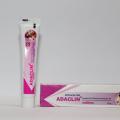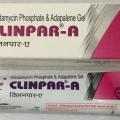Home / Categories / CLINBACT PLUS GEL

CLINBACT PLUS GEL
CLINDAMYCIN-1%W/W
ADAPALENE-0.1% W/W
ANTI-ACNE DRUGS
ASIAN PHARMACEUTICALS-NAISA-DIVISION
Product Details
Clinbact Plus Gel is used to treat acne. It helps to decrease the number of acne lesions.
CLINDAMYCIN
Class: Antibiotic/Lincosamide
Action Suppresses bacterial protein synthesis.
 Indications Treatment of serious infections caused by susceptible strains of specific microorganisms; treatment of acne vulgaris (topical use); treatment of bacterial vaginosis (vaginal use). Unlabeled use(s): Treatment of CNS toxoplasmosis in AIDS patients, Organism: Pneumocystis carinii pneumonia and acute pelvic inflammatory disease; treatment of rosacea (topical).
Indications Treatment of serious infections caused by susceptible strains of specific microorganisms; treatment of acne vulgaris (topical use); treatment of bacterial vaginosis (vaginal use). Unlabeled use(s): Treatment of CNS toxoplasmosis in AIDS patients, Organism: Pneumocystis carinii pneumonia and acute pelvic inflammatory disease; treatment of rosacea (topical).
 Contraindications Hypersensitivity to lincosamides or any product component; treatment of minor bacterial or viral infections; history of regional enteritis, ulcerative colitis or antibiotic-associated colitis.
Contraindications Hypersensitivity to lincosamides or any product component; treatment of minor bacterial or viral infections; history of regional enteritis, ulcerative colitis or antibiotic-associated colitis.
 Route/Dosage
Route/Dosage
ADULTS: PO 150–450 mg q 6 hr. IM/IV 0.6–2.7 g/day divided into 2–4 doses. Do not use > 600 mg in single IM injection. CHILDREN: CLINDAMYCIN HYDROCHLORIDE: PO 8–20 mg/kg/day divided into 3–4 doses. CLINDAMYCIN PALMITATE HYDROCHLORIDE: PO 8–25 mg/kg/day divided into 3–4 doses. CHILDREN > 1 mo: IM/IV 20–40 mg/kg/day divided into 3–4 equal doses. NEONATES < 1 mo: IM/IV 15–20 mg/kg/day divided into 3–4 equal doses.
Acute Pelvic Inflammatory Disease
ADULTS: IV 900 mg q 8 hr with gentamicin. After discharge from hospital continue with doxycycline 100 mg bid for 10 days or oral clindamycin 450 mg 5 times daily for 10–14 days.
Acne
ADULTS: Topical Apply thin film to affected area bid.
Vaginosis
ADULTS: Intravaginal 1 applicatorful preferably at bedtime for 7 days.
 Interactions
Interactions
Erythromycin: May cause antagonism. Kaolin-pectin antidiarrheals: May delay absorption of clindamycin. Nondepolarizing neuromuscular blockers: May enhance actions of blockers. INCOMPATIBILITIES: Ampicillin, phenytoin sodium, barbiturates, aminophylline, magnesium sulfate, calcium gluconate.
 Lab Test Interferences None well documented.
Lab Test Interferences None well documented.
 Adverse Reactions
Adverse Reactions
CV: Hypotension, cardiopulmonary arrest. DERM: Hypersensitivity (eg, skin rash, urticaria, erythema multiforme, some cases resembling Stevens-Johnson syndrome). GI: Diarrhea; colitis, including pseudomembranous colitis; nausea; vomiting; abdominal pain; esophagitis; anorexia. GU: Azotemia; oliguria; proteinuria; cervicitis or vaginitis (with intravaginal form of drug). HEMA: Neutropenia; leukopenia; agranulocytosis; thrombocytopenic purpura. HEPA: Jaundice; liver function test abnormalities. OTHER: Pain after injection; induration and sterile abscess after intramuscular injection; thrombophlebitis after intravenous infusion; anaphylaxis. Topical or vaginal use may theoretically produce adverse effects seen with systemic use as a result of absorption.
 Precautions
Precautions
Pregnancy: Oral, parenteral: Category B. Clindamycin does cross the placenta. Topical, intravaginal: Category B. Lactation: Excreted in breast milk. Children: Monitor organ system functions in newborns and infants; parenteral form may contain benzyl alcohol, which can cause gasping syndrome in premature infants. Colitis: Drug can cause severe and possibly fatal colitis characterized by severe persistent diarrhea, severe abdominal cramps and possibly passage of blood and mucus. Mild cases may respond to drug discontinuation. More severe cases may need fluid, electrolyte and protein supplementation, corticosteroids and other antibiotics. Consider possibility of pseudomembranous colitis. Elderly or debilitated patients: May not tolerate diarrhea well (dehydration). Hypersensitivity: Use drug with caution in patients with asthma or significant allergies. Meningitis: Drug does not diffuse into CSF. Do not use to treat meningitis. Mineral oil: Vaginal cream contains mineral oil, which may weaken latex rubber condoms or diaphragms. Renal or hepatic impairment: Use drug with caution in patients with severe renal or hepatic disease with severe metabolic aberrations. Tartrazine sensitivity: Some products contain tartrazine, which may cause allergic-type reactions in susceptible individuals.
PATIENT CARE CONSIDERATIONS
 Administration/Storage
Administration/Storage
- Administer capsules with full glass of water or with food.
- Give via deep IM injection. Do not administer more than 600 mg in single IM injection. Rotate injection sites.
- For IV infusion, dilute in 50–100 ml D5W or normal saline and infuse over 1 hr. Concentration should not exceed 18 mg/ml.
- Administer over 10–60 min (not to exceed 30 mg/min). Do not infuse as intravenous bolus.
- Do not infuse more than 1200 mg in 1 hr.
- Do not apply topical solution to abraded skin or mucous membranes.
- Keep vaginal cream and topical solution out of eyes.
- Store reconstituted clindamycin palmitate (pediatric oral solution) at room temperature for up to 2 wks. Do not refrigerate (causes thickening).
 Assessment/Interventions
Assessment/Interventions
- Obtain patient history, including drug history and any known allergies. Check for renal or hepatic impairment, GI disease, asthma or significant allergies.
- When administering drug to newborns or infants, monitor organ system functions.
- With long-term therapy monitor liver and kidney function tests and blood counts.
- Report symptoms of colitis (severe diarrhea, severe abdominal cramps, passage of blood or mucus) to physician immediately. Symptoms may occur up to several wk after cessation of therapy.
- Be alert for the possibility of bacterial or fungal overgrowth on nonsusceptible organisms, especially yeasts.
 Patient/Family Education
Patient/Family Education
- Advise patient to take capsules with full glass of water or with food.
- Instruct patient using vaginal cream not to engage in sexual intercourse during treatment.
- Advise patients using vaginal cream that if they do engage in sexual intercourse not to use rubber or latex birth control devices (condoms, cervical caps or diaphragms) for 72 hr after treatment. Vaginal cream contains mineral oil, which may weaken latex rubber condoms or diaphragms.
- Teach patient to be careful to keep vaginal cream and topical solution out of eyes.
- Instruct patient not to apply topical solution to abraded skin or mucous membranes.
- Advise patient to notify physician if hypersensitivity reaction occurs (skin rash, urticaria, erythema multiforme) or if symptoms of disease being treated worsen.
- Instruct patient to notify physician if diarrhea develops; patient should not try to treat with otc medications. (Taking Lomotil [diphenoxylate compound] may prolong and worsen diarrhea.)
ADAPALENE
| Class: Retinoid |
Action May normalize the differentiation of follicular epithelial cells, resulting in decreased microcomedone formation.
 Indications Topical treatment of acne vulgaris.
Indications Topical treatment of acne vulgaris.
 Contraindications Standard considerations.
Contraindications Standard considerations.
Adults and children (12 yr and older): TOPICAL Apply a thin film once daily to affected areas after washing in the evening before bedtime.
Potentially irritating topical products (eg, medicated or abrasive soaps and cleansers, soaps and cosmetics that have strong drying effect, products with high concentrations of alcohol, spices or limes), products containing sulfur, resorcinol, or salicylic acid: Because of increased risk of local irritation, use with caution.
 Lab Test Interferences None well documented.
Lab Test Interferences None well documented.
DERMATOLOGIC: Erythema; scaling; dryness; pruritus, skin discomfort, burning, stinging, and irritation; sunburn; acne flares.
Pregnancy: Category C. Lactation: Undetermined. Children: Safety and efficacy not established in children less than 12 yr. External use: Avoid contact with eyes, lips, angles of the nose, other mucous membranes, and open wounds. Irritation: May cause local irritation. May need to use less often or discontinue use. Photosensitivity: Photosensitivity may occur. Patients should minimize exposure to sunlight, including sunlamps, and use sunscreens and protective clothing over treated areas.
| PATIENT CARE CONSIDERATIONS |
|
- For topical use only. Not for ophthalmic, oral, or intravaginal use.
- Avoid contact with eyes, lips, angles of the nose, and mucus membranes.
- Cleanse area with a mild or soapless cleanser before applying medicated cream.
- Cream, gel, or solution are usually applied to affected areas once daily at nighttime.
- Apply a thin film of cream, gel, or solution to cover the affected area(s).
- Store at controlled room temperature (68° to 77°F). Keep tube tightly capped. Keep bottle tightly capped and stored upright. Protect from freezing.
Solution
- Apply directly to affected area(s) using supplied applicator. Replace cap after each use.
Pledgets
- Do not use if seal is broken. Remove pledget from foil pouch just before using. Discard pledget after single use. Do not reuse pledget.
- Obtain patient history, including drug history and any known allergies.
- Assess the skin and identify areas where medication is to be applied and areas that are sunburned, have cuts, eczema, or abrasions; avoid these areas.
- Assess and document skin condition before initial application and periodically throughout treatment.
- Monitor for side effects, including redness, scaling, dryness, or persistent itching or burning. Inform health care provider if noted and significant.
|
||||
- Explain name, dose, action, and potential side effects of drug.
- Advise patient that medication is applied topically to skin lesions once daily at nighttime.
- Teach patient the following proper technique for applying medication: wash hands; cleanse area with mild or soapless cleanser first then apply a thin film of cream, gel, or solution to cover skin areas with acne lesions; wash hands after applying medication.
- Inform patient that a mild sensation of warmth or slight stinging may be felt shortly after application and that this is expected and should be of no concern.
- Warn patient that applying medication more often than prescribed or in excessive quantities will not produce more rapid improvement or better results but will result in greater side effects such as redness, scaling, and discomfort.
- Warn patient to avoid contact with the eyes, lips, angles of the nose, and mucous membranes.
- Advise patient to not apply to skin areas where there are cuts, abrasions, or eczema, or to sunburned skin.
- Advise patient that moisturizers may be used but to avoid those containing alpha hydroxy or glycolic acids.
- Advise patient that acne may appear to worsen during the first few weeks of therapy but to continue to use the cream. Improvement may not be seen for at least 2 wk but may take up to 8 wk.
- Advise patient that local redness, drying, scaling, burning, or itching may occur during the first 2 to 4 wk of treatment and usually will lessen with continued use of medication. However, if these symptoms are bothersome or do not go away, the frequency of application may need to be reduced or the medication discontinued completely.
- Advise patient that if severe dermal reactions occur to stop using the medication and contact the health care provider.
- Advise patient to talk to the health care provider before using any other topical agents (eg, medicated soaps, astringents, cosmetics, or other acne products) on treated skin.
- Advise patient to not use wax epilation on treated skin because of risk of skin erosions.
- Warn patient to avoid unnecessary exposure to sun and sun lamps while using this medication. Advise patient to use sunscreens and protective clothing over treated areas when exposure cannot be avoided.
- Caution patient that while using the medication, exposure to extreme weather conditions (eg, wind or cold air) may be irritating to the treated areas.
- Advise women to contact health care provider if pregnant, planning to become pregnant, or breastfeeding.
- Warn patient not to take any prescription or OTC drugs or dietary supplements without consulting the health care provider.
- Advise patient that follow-up visits to examine the skin lesions may be necessary and to keep appointments.
Books@Ovid
Copyright © 2003 Facts and Comparisons
David S. Tatro
A to Z Drug Facts
Substitutes


